3.1.1: Chelating Ligands
- Page ID
- 200858
Introduction
Each ligand that binds to a transition metal donates a pair of its electrons to the metal, sharing those electrons in a metal-ligand bond. Counting the total number of electrons in the metal's valence shell is fairly easy when you know that each ligand contributes two electrons.
But what if a ligand could contribute more than two electrons? Take a look at the following table. Each of the ligands shown here can bind to a metal twice. The ligand forms two bonds to the metal, donating two pairs of electrons. It might seem obvious, but forming two bonds to the metal means the ligand binds more tightly to the metal. Remember the lego-like nature of transition metal complexes: ligands can come and go, but these ligands are less likely to go; they hold on.
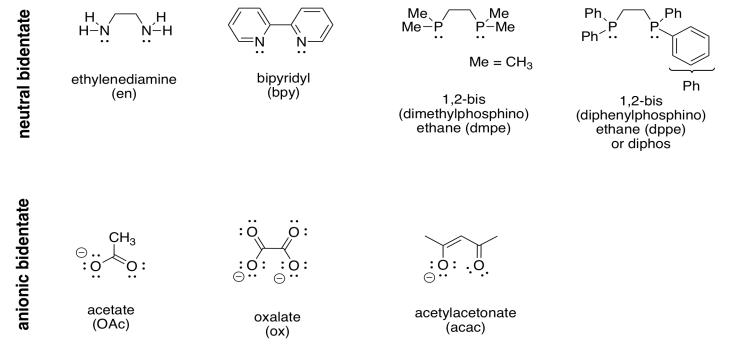
These ligands are called bidentate ligands. That means, literally, that they have two teeth. That does not sound like much, but the ligands we have seen previously are described as monodentate; they have only one tooth. Bidentate ligands can bite into and hold onto the metal more strongly than monodentate ligands.
Another term used for these kinds of ligands is derived from the Greek chele, for claw. These ligands grab onto the metal like the claw of a lobster or crab; they chelate. The "chelate effect" (see next section) is the tendency of these ligands to bind firmly to a metal, whereas monodentate ligands might come off more easily.
Denticity
Denticity refers to the number of atoms with which a ligand binds to a metal ion. A ligand could be monodentate, meaning it binds through a lone pair on a single atom. It could be bidentate, meaning it binds through lone pairs on two different atoms. It could even be tridentate, with three atoms bearing their own lone pairs, tetradentate, and so on. The words, polydentate and multidentate, are two general terms for ligands that bind through more than one atom. The words chelator and chelating ligand are also general terms used to refer to these ligands.
Figures \(\PageIndex{2}\) and \(\PageIndex{3}\) Examples of polydentate ligands.

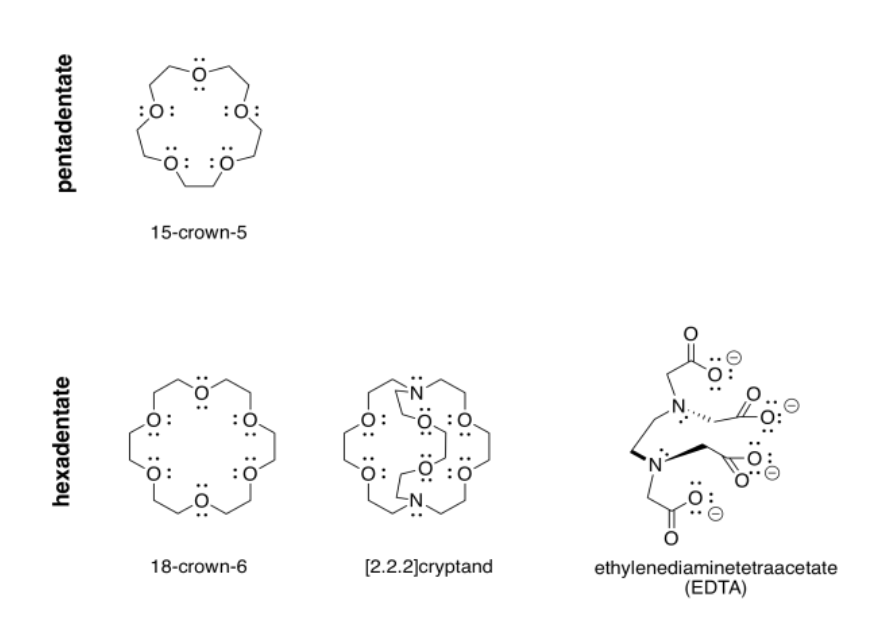
There is a symbol for denticity, κ (it's a Greek letter, pronounced "kappa"), which simply describes how many atoms are bound to the metal. For example, in ethylenediamine or 1,2-diaminoethane, NH2CH2CH2NH2, the two nitrogen atoms can be bound to the metal at the same time, although none of the other atoms in between would be directly attached to the metal. This donor is capable of binding in a κ2 mode. However, if for some reason one of the nitrogen atoms lets go of the metal so that the ethylenediamine is hanging on by only one nitrogen, we would say that the ligand is binding in κ1 mode.
In each of the following cases,
i) describe the denticity;
ii) indicate the charge on the ligand and on the metal.

- Answer a):
-
tridentate or κ3; ligand = 0; metal = 1+
- Answer b):
-
bidentate or κ2; ligand = 1-; metal = 0
- Answer c):
-
bidentate or κ2; ligand = 0; metal = 2+
- Answer d):
-
tetradentate or κ4; ligand = 2-; metal = 2+
- Answer e):
-
tridentate or κ3; ligand = 0; metal = 1+
- Answer f):
-
bidentate or κ2; ligand = 0; metal = 1+
Isomers
Coordination isomers in polydentate ligands
Now, just because a ligand could bind through multiple atoms does not mean that it always binds that way. That's often true with the acetate ligand, for example, because the four-membered ring that forms when it binds through both oxygen atoms is a little too strained. Consequently, there are examples of binding through both oxygen atoms, and there are also examples of binding through only one. Sometimes, acetate uses one oxygen to bind to one metal atom and the other oxygen to bind to a second metal atom, forming a bridge.

Usually, if a ligand is capable of chelation, assume it binds that way. However, there may be cases in which you are asked specifically to draw it binding in one way or another.
In the following cases, the ligand has slipped so that it isn't binding as tightly as it possibly could. In each case,
i) describe the denticity as drawn;
ii) state the maximum denticity possible;
iii) indicate the charge on the ligand and on the metal.
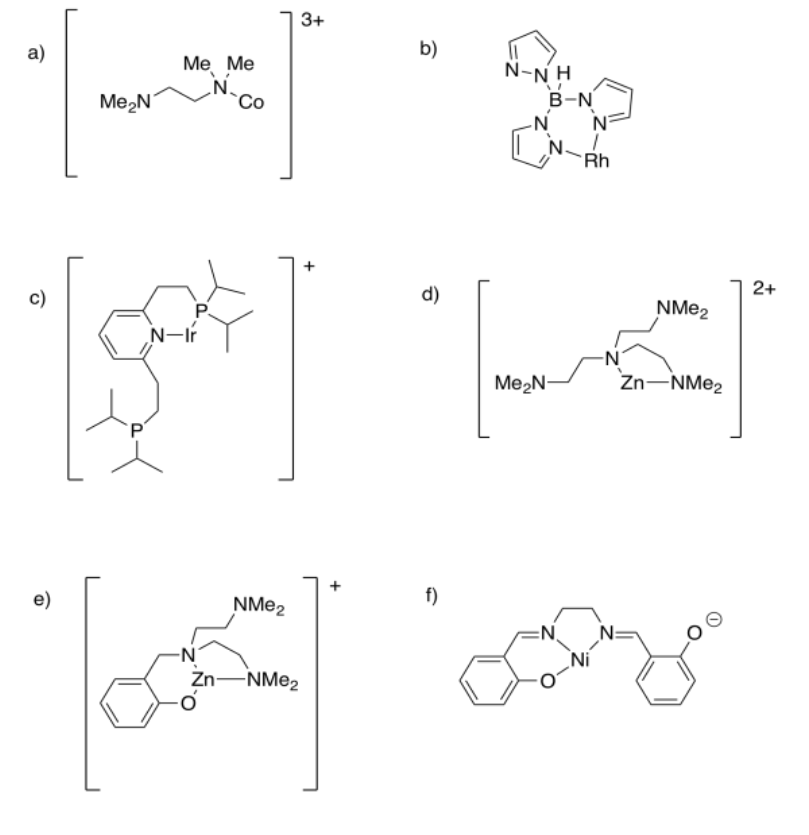
- Answer a):
-
monodentate or κ1; maximum bidentate or κ2; ligand = 0; metal = 2+
- Answer b):
-
bidentate or κ2; maximum tridentate or κ3; ligand = 1-; metal = 1+
- Answer c):
-
bidentate or κ2; maximum tridentate or κ3; ligand = 0; metal = 1+
- Answer d):
-
bidentate or κ2; maximum tetradentate or κ4; ligand = 0; metal = 2+
- Answer e):
-
tridentate or κ3; maximum tetradentate or κ4; ligand = 1-; metal = 2+
- Answer f):
-
tridentate or κ3; maximum tetradentate or κ4; ligand = 2-; metal = 2+
Determine the denticity of each ligand in the following complexes.
a) [Cu(en)2(OH)2] b) [RuCl2(dmpe)(bpy)] c) [Ni(acac)2(OH2)2] d) K2[Cu(ox)2(OH2)2]
e) [FeH2(dmpe)2] f) [RuH(OAc)(PPh3)3] g) [Co(en)2Cl2]BF4 h) [Ru(bpy)2(HOCH2CH3)2](ClO4)2
- Answer a):
-
en = bidentate; OH = monodentate
- Answer b):
-
dmpe = bidentate; bpy = bidentate; Cl = monodentate
- Answer c):
-
acac = bidentate; H2O = monodentate
- Answer d):
-
ox = bidentate; H2O = monodentate
- Answer e):
-
dmpe = bidentate; H = monodentate
- Answer f):
-
H = monodentate; PPh3 = monodentate; OAc = bidentate. In this case, the acetate gets the complex to 18 electrons by binding twice.
- Answer g):
-
en = bidentate; Cl = monodentate
- Answer h):
-
bpy = bidentate; HOCH2CH3 = monodentate
Determine the charges (or oxidation states) on the metals in the following complexes:
a) K[Cr(ox)2(OH2)2] b) K[Mn(acac)3] c) [Cr(en)2Cl2]PF6 d) [Co(en)2(OH)Cl]ClO4
e) Na3[Mn(ox)3] f) K3[Cr(ox)3] g) Na[Au(bpy)(CN)2]
- Answer a):
-
Overall charge = 1-; ligands charge = 4-; charge on Cr = 3+
- Answer b):
-
Overall charge = 1-; ligands charge = 3-; charge on Mn = 2+
- Answer c):
-
Overall charge = 1+; ligands charge = 2-; charge on Cr = 3+
- Answer d):
-
Overall charge = 1+; ligands charge = 2-; charge on Co = 3+
- Answer e):
-
Overall charge = 3-; ligands charge = 6-; charge on Mn = 3+
- Answer f):
-
Overall charge = 3-; ligands charge = 6-; charge on Cr = 3+
- Answer g):
-
Overall charge = 1-; ligands charge = 2-; charge on Au = 1+
Determine the electron count on the metal in each of the complexes from the previous problem.
- Answer a):
-
Cr = d6; Cr3+ = d3; ox = 2 x 4e- = 8 e-; water = 2 x 2e- = 4 e-; total = 15 e-
- Answer b):
-
Mn = d7; Mn2+ = d5; acac = 3 x 4e- = 12 e-; total = 17 e-
- Answer c):
-
Cr = d6; Cr3+ = d3; en = 2 x 4e- = 8 e-; Cl = 2 x 2e- = 4 e-; total = 15 e-
- Answer d):
-
Co = d9; Co3+ = d6; en = 2 x 4e- = 8 e-; OH = 2e-; Cl = 2 e-; total = 15 e-
- Answer e):
-
Mn = d7; Mn3+ = d4; ox = 3 x 4e- = 12 e-; total = 16 e-
- Answer f):
-
Cr = d6; Cr3+ = d3; ox = 3 x 4e- = 12 e-; total = 15 e-
- Answer g):
-
Au = s1d10; Au1+ = d10; bpy = 2 x 2e- = 4 e-; cyanide = 2 x 2e- = 4 e-; total = 18 e-
Stereoisomers in polydentate ligands
Polydentate ligands can give \(\Lambda\)\\(\Delta\) isomers and mer\fac isomers, respectively. See the examples below.

Figure \(\PageIndex{7}\): The two molecules shown on the left are \(\Lambda\) and \(\Delta\) stereoisomers of tris(ethylenediamine)cobalt(III). The two molecules on the right are fac and mer isomers of diethylenetriaminetrichlorocobalt(III).
More details on isomers are provided in a more advanced course.
Bite Angle
There are more subtle aspects of chelation. For example, two different bidentate ligands may not necessarily bind to the metal in exactly the same way. In the drawing below, it's apparent that the three bidentate phosphine ligands, bis(dimethylphosphino)methane, bis(dimethylphosphino)ethane, and bis(dimethylphosphino)propane, do not all bind the metal with the same geometry. In each case, the metal forms a different angle with the two phosphines.

The term "bite angle" is frequently used to describe how different bidentate ligands will attach to metals at different angles. In the picture, the P-Pd-P angle appears to be about 90 degrees when dmpm is bound; in reality it is even smaller. With dmpe, the bite angle appears larger in the picture than the one for dmpm, and in reality it is larger, although not quite as large as it appears here. Two different ligands that bind with two different bite angles will have different influences on the complex that forms. In fact, chemists often use these differences to "tune" the behavior of transition metals that are used as catalysts for important properties. They might add similar ligands with different bite angles to see which one best promotes the desired catalytic reaction.
Many factors can influence the bite angle, including structural features of the bidentate ligand itself, the metal, and other ligands bound to the metal. However, a particular ligand will usually have a normal range of bite angles that it will be able to adopt under different circumstances.
Certain ligands may have natural bite angles that work better in some cases than in others. Propose the optimum bite angle in each of the following geometries.

- Answer a):
-

- Answer b):
-
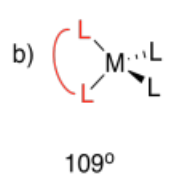
- Answer c):
-
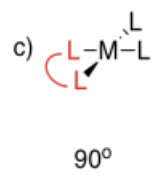
- Answer d):
-

Certain ligands tend to give a certain range of bite angles. Use the suggested criterion to predict which ligand in each pair would give the larger bite angle.

- Answer a):
-
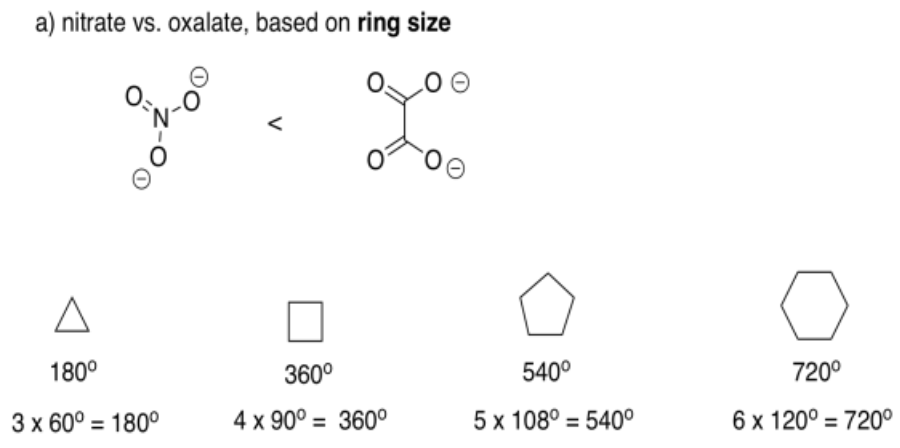
The total of the interior angles of a regular polyhedron is given by (n-2)180o, in which n is the number of sides in the polyhedron. Assuming the ring formed by the bidentate ligand and the metal is a regular polyhedron (it won't be, but we are simplifying), then nitrate gives a triangle with 60° angles, including a 60° O-M-O bite angle. Oxalate gives a square with a larger, 90° bite angle.
In reality, the bite angle for nitrate varies with the complex that is formed, but it is usually somewhere around sixty degrees, whereas oxalate usually gives somewhere around eighty five degrees (see, for example, Alvarez, Chem. Rev. 2015, 115, 13447-13483). The smaller ring size gives a smaller bite angle.
- Answer b):
-

Sulfur is larger than oxygen, so its bonds will be a little longer. As a result, you can imagine those two sides of the square being a little longer with sulfur than with oxygen. From the perspective of the metal, the gap between the two donor atoms widens out a little.
Acetate forms bite angles of around sixty degrees, but dithiocarbamate forms larger bite angles of seventy or seventy five degrees.
- Answer c):
-
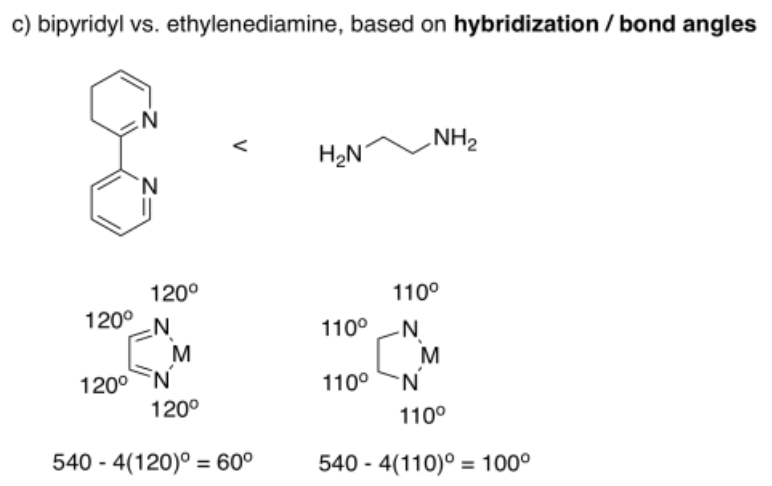
There are lots of differences between these two ligands, but if we simplify and only consider bond angle, we can make a prediction. If the atoms in bipridyl can be considered sp2 hybridised, then they form 120° bond angles. The atoms in ethylenediamine could be considered sp3 hybridised, forming approximately 110° angles. The angle N-M-N still has to complete the shape of the regular pentagon, so if all of the other angles are bigger in the bipyridyl complex, we would expect the bite angle to be smaller.
Really, the bite angles are much closer than this rough estimate suggests. Bipyridyl forms average bite angles of around eighty degrees, whereas ethylenediamine forms average bite angles of around eighty-five degrees. Keep in mind that those are just averages, though. These two values are close enough that their ranges overlap; lots of bipyridyl complexes would have bite angles smaller than ethylenediamine complexes.
Suggest which ligand in each pair would have the larger bite angle, and why.

Figure \(\PageIndex{11}\):
- Answer a):
-

- Answer b):
-
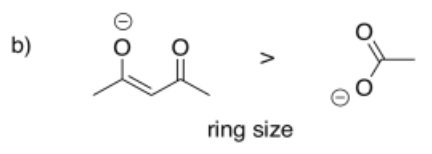
- Answer c):
-
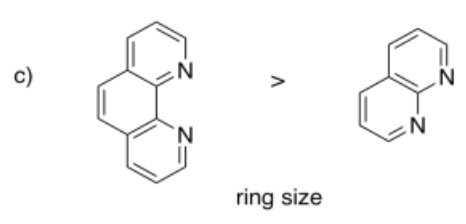
- Answer d):
-

- Answer e):
-

- Answer f):
-

- Answer g):
-
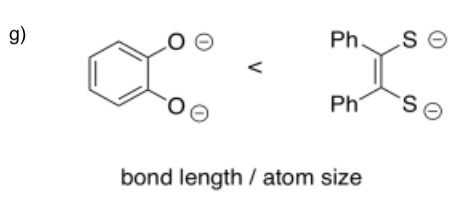
- Answer h):
-
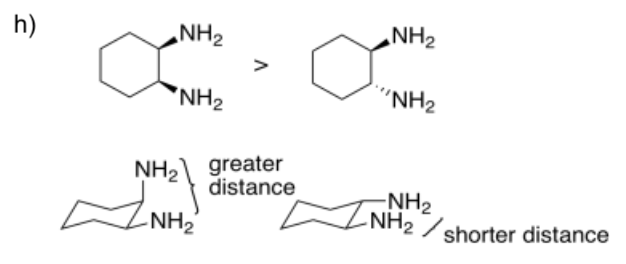
Attribution
This page was modified from the following pages from Chemical Structure and Reactivity by Chris Schaller.
- Chelation (from I: Chemical Structure and Properties)
- Chelation (from III: Reactivity in Organic, Biological and Inorganic Chemistry 1)
Curated or created by Kathryn Haas

